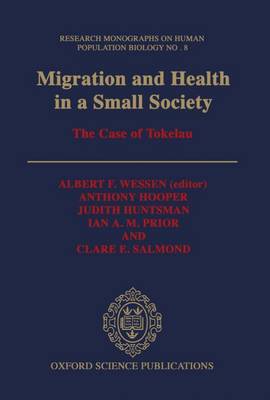Research Monographs in Human Population Biology
1 primary work
Book 8
Migration and Health in a Small Society
by Antony Hooper, Judith Huntsman, Ian A. M. Prior, Clare E. Salmond, and Albert F. Wessen
Published 14 May 1992
Between 1965 and 1975, a large proportion of the population of Tokelau, a group of three tiny isolated atolls in the tropical South Pacific, migrated to New Zealand, where they became part of a cosmopolitan urban society. By 1985, two-thirds of all Tokelauans lived in New Zealand. This book traces the experience of the Tokelauans, both migrant and non-migrant, during the period 1965-85. The analysis is interdisciplinary, drawing upon historical, ethnographic,
sociological, and epidemiological materials.
Topics discussed include the ecology and history of Tokelau, the nature of Tokelauan culture and society, the problems of adaptation faced by migrants to New Zealand and their efforts to develop a viable Tokelauan community there, the impact of modernizing influences upon atoll society, changes in the health status of both migrant and non-migrant Tokelauans, and their relationship of social change to the health of the population. Special attention is paid to the hypothesis that the migrants'
adaptation to modern urban society would lead to increased incidence of such chronic conditions as hypertension, coronary heart disease, asthma, and diabetes.
sociological, and epidemiological materials.
Topics discussed include the ecology and history of Tokelau, the nature of Tokelauan culture and society, the problems of adaptation faced by migrants to New Zealand and their efforts to develop a viable Tokelauan community there, the impact of modernizing influences upon atoll society, changes in the health status of both migrant and non-migrant Tokelauans, and their relationship of social change to the health of the population. Special attention is paid to the hypothesis that the migrants'
adaptation to modern urban society would lead to increased incidence of such chronic conditions as hypertension, coronary heart disease, asthma, and diabetes.
